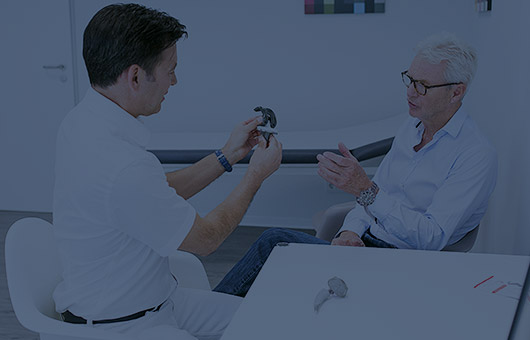Information about the hip prosthesis operation
Video: “The new hip prosthesis -- AMIS and navigation, what is optimal?” (german language)
The new hip
Hip prosthetics have greatly developed in recent years. Current surgical techniques such as minimally invasive AMIS access or new navigation devices have made the operation safer and more gentle. Thanks to modern short stem prostheses and high quality materials lifelong durability is possible.
The principle of a total hip replacement
A hip prosthesis replaces the parts of the hip joint that have worn out over decades of use and are the cause of your problems: the femoral head and the hip socket. Your new hip consists of several parts, just like a natural hip joint (total hip endoprosthesis: Hip – TEP). The “shaft” with a ball head replaces the worn femoral head. Your hip socket is replaced by a “cup”. The result: The new ball head moves perfectly in the new cup – and without pain for you.

The muscle protective AMIS approach (Anterior Minimally Invasive Surgery)
The direct anterior AMIS approach is based on surgical principles that are not comparable to standard minimally invasive techniques. This approach will not in any way damage the major gluteal muscles . This is the only technique that takes into account inter-muscular levels and reduces the risk of muscle and tendon injury. For this reason, the AMIS surgical technique is the ideal gateway for a gentle operation and a speedy recovery.
However, this approach is not technically possible for all patients – for example, in osteoporotic bones or significant obesity. Alternatively, I then use a minimally invasive lateral (anterolateral) approach. Very good results are also achieved with this standard access. This qualified service is only offered by very few doctors in the Rhine-Main area.

Advantages of AMIS technology
- Lower risk of limping: The anterior surgical technique reduces muscle damage, thereby reducing the risk of limping.
- Reduced post-operative pain: Compared to conventional surgical techniques, the anterior approach can reduce post-operative pain because no muscles are damaged. The patients often have no more pain after the first days.
- Quicker return to daily activities: Thanks to the anterior technique, the quicker return to everyday activities is possible. After consultation with your doctor, and depending on the general condition, you can normally drive independently again after three to four weeks.

Perfect positioning with the help of navigation
To assist the surgeon in the procedure, navigation systems have been developed. They provide the surgeon with accurate data on the planned bone processing and the final position of the implants. You can imagine the system as a type of GPS for the hip, which works with reflectors. The system works on an optical principle and has nothing to do with a so-called surgical robot. I use the most up-to-date system from Naviswiss, which I attended as a medical consultant until it was ready for series production. The navigation system supports the doctor during the individual work steps and sends exact coordinates. For you as a patient, a navigated procedure means that two additional small punctures are needed on the pelvic skin. Marker pins are attached there during the procedure.
For moving parts, such as the new femoral head, specially developed ceramics are used. Inserts made of highly cross-linked polyethylene are used as a gliding partner of the head. The life span of an artificial joint can not be accurately predicted. But you have a high probability that your new hip will last for about 25 to 30 years with today’s materials.

The choice of fixation technique
Secure fixation of the implants in the bone is crucial for the function of the hip prosthesis . A metal cup in the area of the pelvis can usually be anchored without cement. Stably wedging the wedging the prosthetic stem in the bone at the femur is essential. If the bone quality is sufficiently good, this anchorage without cement succeeds in about 90% of the patients. Depending on the carrying capacity and shape of the bone, I will implant a short stem. The bone begins to grow on the roughened metal surface within four to six weeks, so that the implants are firmly integrated into the body. If during the operation a cementless short or standard stem cannot be stabily fixed so that dangerous rotational forces can be intercepted, I will decide to securely anchor the shaft with cement. According to many scientific studies, the type of anchorage has no effect on the durability of the hip prosthesis.

Material specifications
The material for an implant must be robust and resilient, but also easy to work with, so that the doctor can fit it perfectly. The highest quality materials are just good enough for a new joint. Pure titanium and its special alloys are used very often. They are very resistant and bond very well with bone. Titanium is presently the best material for the hip socket. The bone grows in a short time to these titanium compounds, which are coated with a so-called bone attractant (calcium phosphates), and fixes the prosthesis.
Specially developed ceramics, such as the new femoral head, are used for moving parts. Inserts made of highly cross-linked polyethylene are used in the joint cup as a gliding partner of the head. The life span of an artificial joint can not be accurately predicted. There is a high probability that your new hip will last for about 25 to 30 years with today’s materials.


